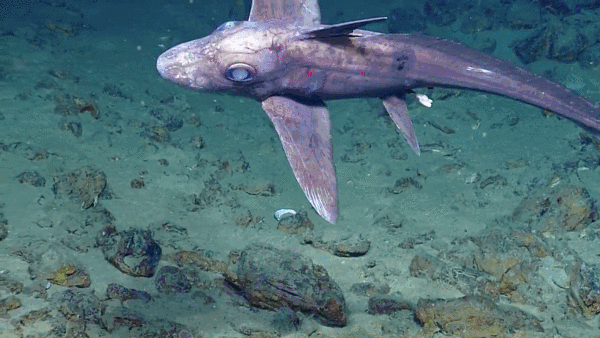
Meet the chimaeras, or “ghost sharks” as they’re sometimes called because of their spooky appearance. These unique and unusual creatures are rarely caught on film — but we’ve gotten a hold of some footage which you find at the bottom of the article!
Despite the name, they aren’t actually sharks. They are cousins and have some similar characteristics, but their evolutionary lineage branched off from sharks almost 400 million years ago.

Image: NOAA Okeanos Explorer Program via Flickr (CC BY-SA 2.0)
In fact, chimaeras are one of the oldest species of fish alive today. They even existed before dinosaurs!
Like sharks, chimaeras are cartilaginous, which means their skeletons are made mostly of cartilage instead of bone. They also have smooth, scaleless skin.

Chimaeras go by different names, including ghost sharks, spookfish, rabbitfish, ratfish, and elephant fish, depending on how they look.
Scientists who named this species of fish may have been inspired by the chimera, which in Greek mythology was a fire-breathing monster with the head of a lion, body of a goat and tail of a snake. The resemblance to so many animals, as well as the lateral lines running across the ghost shark’s head and body certainly gives it a patched-together appearance.
They have three pairs of sharp, grinding teeth, which they use to crush through crustacean shells (and contributes to their rodent-inspired names.)
Male ghost sharks have a retractable sex organ on their foreheads that they use to hold females closer while mating. They also have claspers near their pelvic fins which they use for reproduction.
Image: Seascapeza via Wikimedia Commons (CC BY-SA 3.0)
The females lay their eggs in long, leathery cases. The capsules, which can take 8-12 months to hatch, have hard, frilly-looking edges and change color from yellow to brownish-black over time.
Some ghost sharks have sharp venomous spines in front of their dorsal fins, which they use to defend themselves from predators.
Chimaeras hunt prey using their large snouts which can detect movement and weak electrical fields.

Their large, eerie eyes sometimes appear to glow in the dark. This is because of a membrane in the eye that absorbs and reflects light, helping the fish see under water.
Ghost sharks typically confined to ocean waters up to 8,500 feet deep and are mostly inaccessible to researchers.
They are caught commercially when they migrate to shallower waters in the spring and summer. In New Zealand, their flesh is sold in markets as whitefish fillets and sometimes used to make fish and chips!
See the first footage that was ever taken of the ghost shark in the video below:




